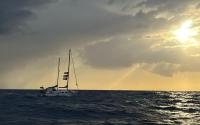The IndependentRussia planted a rust-proof titanium flag on the seabed beneath the North Pole yesterday, marking the start of a new global struggle to claim the vast mineral wealth of the Arctic Ocean.
Estimates suggest that the area to which Russia is laying claim contains billions of tonnes of oil and gas reserves as well as other minerals.
The mini-submarine Mir 1, one of a pair, reached the seabed 13,980ft (4,261m) beneath the North Pole first.
The expedition was led by Artur Chilingarov, the polar explorer and deputy speaker of the Duma, the Russian parliament. He was accompanied by a second parliamentarian, Vladimir Gruzdev, and Anatoli Sagalevich, chief of the Oceanology Institute at the Russian Academy of Sciences.
Mir 1 was under water for almost nine hours. Vladimir Strugatsky, the vice-president of the Association of Polar Explorers of the Russian Federation, said that it had spent 40 minutes searching for a hole in the ice to resurface.
When it was hauled back on board the Akademik Fedorov research ship, Mr Chilingarov, 68, said: “It was so good down there. If someone else goes down there in 100 or 1,000 years, he will see our Russian flag. There is yellowish gravel down there. No creatures of the deep are visible.”
The second vessel, Mir2, resurfaced an hour later. Its crew included Michael McDowell, an Australian, and Frederik Paulsen, a Swedish pharmaceuticals millionaire described as a co-sponsor of the expedition. It reached 350ft deeper. The vessels recovered samples from the seabed in an attempt to demonstrate that the Lomonosov Ridge, an underwater shelf that runs through the Arctic, is an extension of Russian territory. The Kremlin has poured £40 million into the voyage and President Putin awarded Mr Chilingarov the status of presidential envoy to the Arctic.
Sergei Lavrov, the Russian Foreign Minister, said that the success of the expedition would “supply additional scientific evidence for our aspirations”. He insisted that Russia’s claim would be resolved “in strict compliance with international law”, adding: “The expedition aims to prove that our shelf extends to the North Pole rather than at staking out Russia’s claims.”
Peter MacKay, the Canadian Foreign Minister, poured scorn on Moscow’s ambitions. He said: “This isn’t the 15th century. You can’t go around the world and just plant flags and say, ‘We’re claiming this territory’.”
Russia has long sought to extend its boundary and lodged a claim in 2001 to 1.2 million sq km of ocean with the UN Convention on the Law of the Sea. The UN asked Russia for more data. The underwater exploration is collecting evidence for a fresh Russian submission in 2009, the centenary of the first journey to the North Pole. A second expedition left the northern port of Archangel yesterday for a 100-day research mission.
Canada and the other Arctic nations – Norway, the United States and Denmark, through its sovereignty over Greenland – have challenged Russia’s claims. Under international law, each is entitled to control an economic zone within 200 miles of their continental shelf, but the limits of the shelf are disputed.
Denmark and Canada argue that the Lomonosov Ridge is connected to their territories. Norway is also conducting a survey to strengthen its case.






